|
 What is Tinplate? - Long before the age of plastics and stainless steel, sheet steel was used for making containers, toys, and many other objects used in most American and European homes between the mid-1700s and mid-1900s. To slow the steel's corrosion, a layer of molten tin was applied to both sides while the material was still in sheet form. Then stamping plants or tinsmiths would fabricate the "tinplate" into its final form, soldering pieces together when necessary. What is Tinplate? - Long before the age of plastics and stainless steel, sheet steel was used for making containers, toys, and many other objects used in most American and European homes between the mid-1700s and mid-1900s. To slow the steel's corrosion, a layer of molten tin was applied to both sides while the material was still in sheet form. Then stamping plants or tinsmiths would fabricate the "tinplate" into its final form, soldering pieces together when necessary.
One of the largest consumers of tinplate has been the canning industry, although tinplate had hundreds of other uses just a century ago. Many popular tinplate toys of the 1800s, especially banks, are collectible today. When toy trains began to be mass-produced, it is no surprise that tinplate was widely used for them as well.
Initially, many tinplate trains and accessories used three-dimensional stamping to add detail. However, a few factories discovered that lithograpy, a kind of printing that uses etched stone, could add color and detail at the same time, without having to have the rivets physically milled into the stamp. Later, companies like Marx, trying to hold down costs, discovered that you could use the same basic "stamp" (or shape) to manufacture a dozen different items, just by changing the artwork.
 
Companies that made toy buildings to go with toy trains discovered this even earlier - so a number of companies made several buildings from the same "stamp" just by changing the graphics.
Note: Companies like Lionel used tinplate to make their track until fairly recently. So model railroaders call almost any toy trains that were built to run on tinplate track "Tinplate," even if the train's bodies are made of plastic. But we are using the word "tinplate" in its earlier meaning, to describe trains and accessories that are actually made from sheet steel that has been coated with tin, and stamped into shape.
Tinplate Reproductions as a Hobby - for years, folks who admired the old tinplate trains and accessories have been not only collecting, but also making their own, trying to use materials similar to those used by the original manufacturers.
In early 2009, project designer Howard Lamey began dabbling with making his own  tinplate train cars, modeled after the O gauge Marx lithographed cars of the 1930s and '40s. One principle he discovered was that many Marx cars had exactly the same body - they just had different lithography. In fact, some folks were providing "wraps", labels that could be cut and glued to old Marx bodies that were damaged too much to restore. tinplate train cars, modeled after the O gauge Marx lithographed cars of the 1930s and '40s. One principle he discovered was that many Marx cars had exactly the same body - they just had different lithography. In fact, some folks were providing "wraps", labels that could be cut and glued to old Marx bodies that were damaged too much to restore.
Howard's experiences reminded me of something I had thought about long ago and done nothing about - the notion of using modern computer graphics to create reproductions of the lithographed-style buildings that accompanied many tinplate railroads over the years.
 So I collected as many photographs as I could find of early 1900s-era stations and other structures. I had always liked the American Flyer Hyde Park Station, on which our first joint project was based. While I was creating the graphics for that project, Howard created the Watchman's Shanty project on his own, and we both liked the results so much that we decided that we had to make it a series. So I collected as many photographs as I could find of early 1900s-era stations and other structures. I had always liked the American Flyer Hyde Park Station, on which our first joint project was based. While I was creating the graphics for that project, Howard created the Watchman's Shanty project on his own, and we both liked the results so much that we decided that we had to make it a series.
Our "Tribute to Tin" Projects So Far
Our "Tribute to TinplateTM" series pays honor to the tinplate villages and trains that surrounded so many Christmas trees in the early 1900s. Examples include:
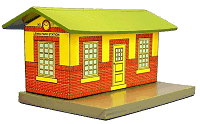 Building a Vintage "Lithograph" Station
Our first official "Tribute to Tinplate" article pays tribute to the lithographed stations of a century ago. The "Lewis Park Station" was inspired by an American Flyer structure designed to go with early O gauge trains. Free downloadable commercial-grade graphics and instructions are available in several scales. Instructions for building this project inexpensively from scrap cardboard are also included, although you could build it from tin if you really wanted to. Building a Vintage "Lithograph" Station
Our first official "Tribute to Tinplate" article pays tribute to the lithographed stations of a century ago. The "Lewis Park Station" was inspired by an American Flyer structure designed to go with early O gauge trains. Free downloadable commercial-grade graphics and instructions are available in several scales. Instructions for building this project inexpensively from scrap cardboard are also included, although you could build it from tin if you really wanted to.
 Building a Vintage Tin-Style Cottage
The "vine covered cottage" was a staple of early 20th century tinplate railroads, originally built to go with Standard Gauge trains, such as those made by Ives and Lionel during the "Golden Age of Toy Trains." Our version includes several choices of color and scale, to work with Lionel sets, display villages, and more. We include free downloadable commercial-grade graphics and instructions. Building a Vintage Tin-Style Cottage
The "vine covered cottage" was a staple of early 20th century tinplate railroads, originally built to go with Standard Gauge trains, such as those made by Ives and Lionel during the "Golden Age of Toy Trains." Our version includes several choices of color and scale, to work with Lionel sets, display villages, and more. We include free downloadable commercial-grade graphics and instructions.
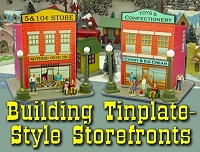 Building TinPlate-Syle Store Fronts -
Not one, but three buildings! This time, Howard Lamey and I are paying tribute to the West Brothers' tinplate candy boxes that would give you a nice city scene once you'd finished off the candy. Like many tinplate toy manufacturers, the West Brothers frequently saved money by using one plan with multiple sets of graphics to get maximum use out of their pattern expense. We've followed their example with projects inspired by three of their most popular buildings. Use our free downloadable patterns and plans to add a vintage-style business district on your railroad or display village. Building TinPlate-Syle Store Fronts -
Not one, but three buildings! This time, Howard Lamey and I are paying tribute to the West Brothers' tinplate candy boxes that would give you a nice city scene once you'd finished off the candy. Like many tinplate toy manufacturers, the West Brothers frequently saved money by using one plan with multiple sets of graphics to get maximum use out of their pattern expense. We've followed their example with projects inspired by three of their most popular buildings. Use our free downloadable patterns and plans to add a vintage-style business district on your railroad or display village.
 Building (Tinplate-Style) Seaside Storefronts - The latest addition to a new favorite. Sticking with the West Brothers outline, we have replaced the brick and stone with clapboard painted in the colors and themes that brighten coastal towns on both coasts. Colors are compatible with Howard Lamey's Sandy Shores beach-inspired collection. New, May, 2010! Building (Tinplate-Style) Seaside Storefronts - The latest addition to a new favorite. Sticking with the West Brothers outline, we have replaced the brick and stone with clapboard painted in the colors and themes that brighten coastal towns on both coasts. Colors are compatible with Howard Lamey's Sandy Shores beach-inspired collection. New, May, 2010!

-
Building a Vintage Cape Cod House - Round out your community with this variation on the cottage above. An easy, but charming "Tribute To Tinplate" structure that looks great with our other projects but will stand fine on its own as well. Includes free plans, graphics, and instructions. Click on the photo for more information. New, February, 2010!
 Building the Tin City Bridge -
Add an eye-popping feature based on the classic Lionel Standard Gauge bridges. Works great with collectible villages, vintage O and S-gauge trains, On30 trains and more! Free downloadable plans, graphic files, and step-by-step instructions are provided. Building the Tin City Bridge -
Add an eye-popping feature based on the classic Lionel Standard Gauge bridges. Works great with collectible villages, vintage O and S-gauge trains, On30 trains and more! Free downloadable plans, graphic files, and step-by-step instructions are provided.
 Building a Lithograph-Style Switch Tower
Every big railroad "yard" had one of these "control towers" that let railroad men watch and operate the switches so trains could be built up, cars could be sorted out, and everyone went where they were supposed to. This "Tribute To Tinplate" with graphics by Paul and assembly tips by Howard Lamey is easy, inexpensive, and impressive. Includes free plans, graphics, and instructions. New, December, 2009!
Building a Lithograph-Style Switch Tower
Every big railroad "yard" had one of these "control towers" that let railroad men watch and operate the switches so trains could be built up, cars could be sorted out, and everyone went where they were supposed to. This "Tribute To Tinplate" with graphics by Paul and assembly tips by Howard Lamey is easy, inexpensive, and impressive. Includes free plans, graphics, and instructions. New, December, 2009!
 Building Flag Day Store Fronts - The latest addition to a new favorite. "Ye Olde Flag Shoppe," "Yankee Doodle Candy," and "Ye Old Fife and Drum Musique Store" projects are all ready to add some 1776 flavor to your railroad or collectible village. Click on the picture for free downloadable graphics, plans and instructions. New, July, 2010! Building Flag Day Store Fronts - The latest addition to a new favorite. "Ye Olde Flag Shoppe," "Yankee Doodle Candy," and "Ye Old Fife and Drum Musique Store" projects are all ready to add some 1776 flavor to your railroad or collectible village. Click on the picture for free downloadable graphics, plans and instructions. New, July, 2010!
 Building a Vintage-Style Diner - Near most busy rail stations stood a diner inspired by the efficient, familiar railroad dining car. Folks coming and going knew they could "nip in" for a quick cup of "Joe" or "drop in" for a home-style meal with all the "fixin's." This project is about the same size as Howard's tinplate Marx coaches, but graphics for bigger versions are available. To get the most "tinplatey" effect possible, Howard used a real steel roof, converted from half of an old eyeglasses case. But even if you don't have that particular resource, this is a great project. New, December, 2009! Building a Vintage-Style Diner - Near most busy rail stations stood a diner inspired by the efficient, familiar railroad dining car. Folks coming and going knew they could "nip in" for a quick cup of "Joe" or "drop in" for a home-style meal with all the "fixin's." This project is about the same size as Howard's tinplate Marx coaches, but graphics for bigger versions are available. To get the most "tinplatey" effect possible, Howard used a real steel roof, converted from half of an old eyeglasses case. But even if you don't have that particular resource, this is a great project. New, December, 2009!
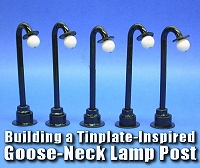 Building a Tinplate-Inspired Goose-Neck Lamp Post -
Another Howard Lamey project: A few cents' worth of materials will give you a traditional-looking accessory to decorate your station platforms and business districts. They don't actually light, but they are ridiculously easy to build, and they bring your railroad, putz, or holiday village a little further back in time just by sitting around. Building a Tinplate-Inspired Goose-Neck Lamp Post -
Another Howard Lamey project: A few cents' worth of materials will give you a traditional-looking accessory to decorate your station platforms and business districts. They don't actually light, but they are ridiculously easy to build, and they bring your railroad, putz, or holiday village a little further back in time just by sitting around.
 Building a Tinplate-Inspired Lamp Post - The ideal accessory for the Lewis Park Station, or any station or city hall on your railroad or holiday village. No, they don't actually light, but they are cheap and easy to build and add a great deal of vintage interest to any setting. Free downloadable plans are available in several scales. Building a Tinplate-Inspired Lamp Post - The ideal accessory for the Lewis Park Station, or any station or city hall on your railroad or holiday village. No, they don't actually light, but they are cheap and easy to build and add a great deal of vintage interest to any setting. Free downloadable plans are available in several scales.
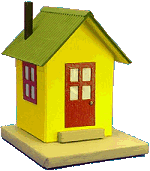 Building a Tinplate-Inspired Watchman's Shanty - Back in the day before automated crossings, these were common sites alongside busy rail crossings. Howard's exclusive design pays tribute to a series of tinplate structures that go back a hundred years and include three different scales. His free plans and instructions will help you dress up any indoor railroad or holiday village. Building a Tinplate-Inspired Watchman's Shanty - Back in the day before automated crossings, these were common sites alongside busy rail crossings. Howard's exclusive design pays tribute to a series of tinplate structures that go back a hundred years and include three different scales. His free plans and instructions will help you dress up any indoor railroad or holiday village.
 Building a Tinplate-Inspired Railroad Crossing Sign - This is the ideal accessory for the Watchman's Shanty project. Based on a series of products that are now available only as expensive collector's items, this easy and almost-free project will add texture, interest, and period to any model railroad or holiday village. Building a Tinplate-Inspired Railroad Crossing Sign - This is the ideal accessory for the Watchman's Shanty project. Based on a series of products that are now available only as expensive collector's items, this easy and almost-free project will add texture, interest, and period to any model railroad or holiday village.
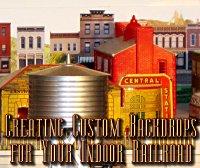 Creating Custom Backdrops for Your Indoor Railroad
Tinplate train fan Ed "Ice" Berg is known in many forums for being a knowledgeable and helpful collector, who, above all, loves to run trains. In this article he describes how he combined graphics from many sources (including our Building Front Photos) to create a detailed, colorful background for his Marx-based railroad. Many of Ed's tips will work for any kind or scale of indoor railroad, so get some ideas about how to bring your blank walls to life. Creating Custom Backdrops for Your Indoor Railroad
Tinplate train fan Ed "Ice" Berg is known in many forums for being a knowledgeable and helpful collector, who, above all, loves to run trains. In this article he describes how he combined graphics from many sources (including our Building Front Photos) to create a detailed, colorful background for his Marx-based railroad. Many of Ed's tips will work for any kind or scale of indoor railroad, so get some ideas about how to bring your blank walls to life.
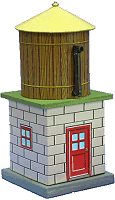 Water Tower with Vintage Lithograph Option - Our Spook HillTM water tower has a new look - well, an old look. With new lithograph-inspired graphics, this one-time Halloween project adds a vintage appearance to any indoor railroad or display village. The core structure is the same, so if you've built one, it's even easier to build the second. New, free, downloadable graphics for two scales are included. Water Tower with Vintage Lithograph Option - Our Spook HillTM water tower has a new look - well, an old look. With new lithograph-inspired graphics, this one-time Halloween project adds a vintage appearance to any indoor railroad or display village. The core structure is the same, so if you've built one, it's even easier to build the second. New, free, downloadable graphics for two scales are included.
- Tinplate Textures - This section includes brick, shingle, siding, door and window patterns inspired by the
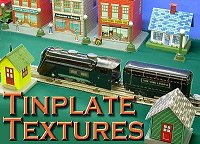 tinplate buildings that Lionel and other companies made to go with their toy trains a century ago. tinplate buildings that Lionel and other companies made to go with their toy trains a century ago.
The Tinplate Textures page provides most patterns in three different scales to help you find the best sizes for your existing railroad or holiday village.
Other Projects of Interest
 Building the Union Station - This original project by designer Howard Lamey is inspired by two traditions - the cardboard Christmas houses that were popular in US homes between 1928 and 1965 and the Lionel station that was popular for most of the 20th century. Building the Union Station - This original project by designer Howard Lamey is inspired by two traditions - the cardboard Christmas houses that were popular in US homes between 1928 and 1965 and the Lionel station that was popular for most of the 20th century.
- Easy Street Scene - This new
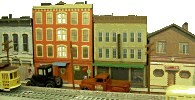 building project uses downloadable building graphics and a little cardboard or foam board to build up a convincing downtown scene that is only a few inches deep - perfect for shelf layouts, tight spots, and dioramas. We also provide links to high-resolution graphics that will work for any scale. building project uses downloadable building graphics and a little cardboard or foam board to build up a convincing downtown scene that is only a few inches deep - perfect for shelf layouts, tight spots, and dioramas. We also provide links to high-resolution graphics that will work for any scale.
-
Build a Vintage-Style Cardboard Stone Cottage - This building project

 is made like the vintage cardboard houses folks used to set around their Christmas tree in the early 1900s (before glitterhouses became common), but its design was inspired by a building that shows up on the "Isle of Sodor." The building uses free downloadable graphic paper to put a realistic stone veneer on an old-world cottage and fence. It works with Christmas villages, or with a little customization, would dress up any indoor railroad. A "brick cottage" option is also shown. is made like the vintage cardboard houses folks used to set around their Christmas tree in the early 1900s (before glitterhouses became common), but its design was inspired by a building that shows up on the "Isle of Sodor." The building uses free downloadable graphic paper to put a realistic stone veneer on an old-world cottage and fence. It works with Christmas villages, or with a little customization, would dress up any indoor railroad. A "brick cottage" option is also shown.
 Log Cabin Building Flat - This "building flat" uses downloadable graphics and foam board or cardboard to dress up a narrow corner of your railroad or village. The techniques in this project can be used for almost any kind of building you want to represent in a tiny space. December, 2007 Log Cabin Building Flat - This "building flat" uses downloadable graphics and foam board or cardboard to dress up a narrow corner of your railroad or village. The techniques in this project can be used for almost any kind of building you want to represent in a tiny space. December, 2007
- Build a Vintage-Style Barn and Silo - This
 building project uses downloadable graphics to put realistic shingles and siding on an old barn and silo. Like the stone cottage above, it works with Christmas villages, or with a few changes, it would dress up an indoor railroad. building project uses downloadable graphics to put realistic shingles and siding on an old barn and silo. Like the stone cottage above, it works with Christmas villages, or with a few changes, it would dress up an indoor railroad.
Other Articles about cardboard houses include:
To Return to the BIG Indoor TrainsTM Primer Page, click here.
|



|




















 What is Tinplate? - Long before the age of plastics and stainless steel, sheet steel was used for making containers, toys, and many other objects used in most American and European homes between the mid-1700s and mid-1900s. To slow the steel's corrosion, a layer of molten tin was applied to both sides while the material was still in sheet form. Then stamping plants or tinsmiths would fabricate the "tinplate" into its final form, soldering pieces together when necessary.
What is Tinplate? - Long before the age of plastics and stainless steel, sheet steel was used for making containers, toys, and many other objects used in most American and European homes between the mid-1700s and mid-1900s. To slow the steel's corrosion, a layer of molten tin was applied to both sides while the material was still in sheet form. Then stamping plants or tinsmiths would fabricate the "tinplate" into its final form, soldering pieces together when necessary.


 tinplate train cars
tinplate train cars So I collected as many photographs as I could find of early 1900s-era stations and other structures. I had always liked the American Flyer Hyde Park Station, on which our first joint project was based. While I was creating the graphics for that project, Howard created the Watchman's Shanty project on his own, and we both liked the results so much that we decided that we had to make it a series.
So I collected as many photographs as I could find of early 1900s-era stations and other structures. I had always liked the American Flyer Hyde Park Station, on which our first joint project was based. While I was creating the graphics for that project, Howard created the Watchman's Shanty project on his own, and we both liked the results so much that we decided that we had to make it a series.
 Building a Vintage "Lithograph" Station
Building a Vintage "Lithograph" Station Building a Vintage Tin-Style Cottage
Building a Vintage Tin-Style Cottage Building TinPlate-Syle Store Fronts
Building TinPlate-Syle Store Fronts

 Building the Tin City Bridge
Building the Tin City Bridge Building a Lithograph-Style Switch Tower
Building a Lithograph-Style Switch Tower Building Flag Day Store Fronts
Building Flag Day Store Fronts Building a Vintage-Style Diner
Building a Vintage-Style Diner Building a Tinplate-Inspired Goose-Neck Lamp Post
Building a Tinplate-Inspired Goose-Neck Lamp Post Building a Tinplate-Inspired Lamp Post
Building a Tinplate-Inspired Lamp Post Building a Tinplate-Inspired Watchman's Shanty
Building a Tinplate-Inspired Watchman's Shanty Building a Tinplate-Inspired Railroad Crossing Sign
Building a Tinplate-Inspired Railroad Crossing Sign Creating Custom Backdrops for Your Indoor Railroad
Creating Custom Backdrops for Your Indoor Railroad Water Tower with Vintage Lithograph Option
Water Tower with Vintage Lithograph Option
 Building the Union Station
Building the Union Station 







